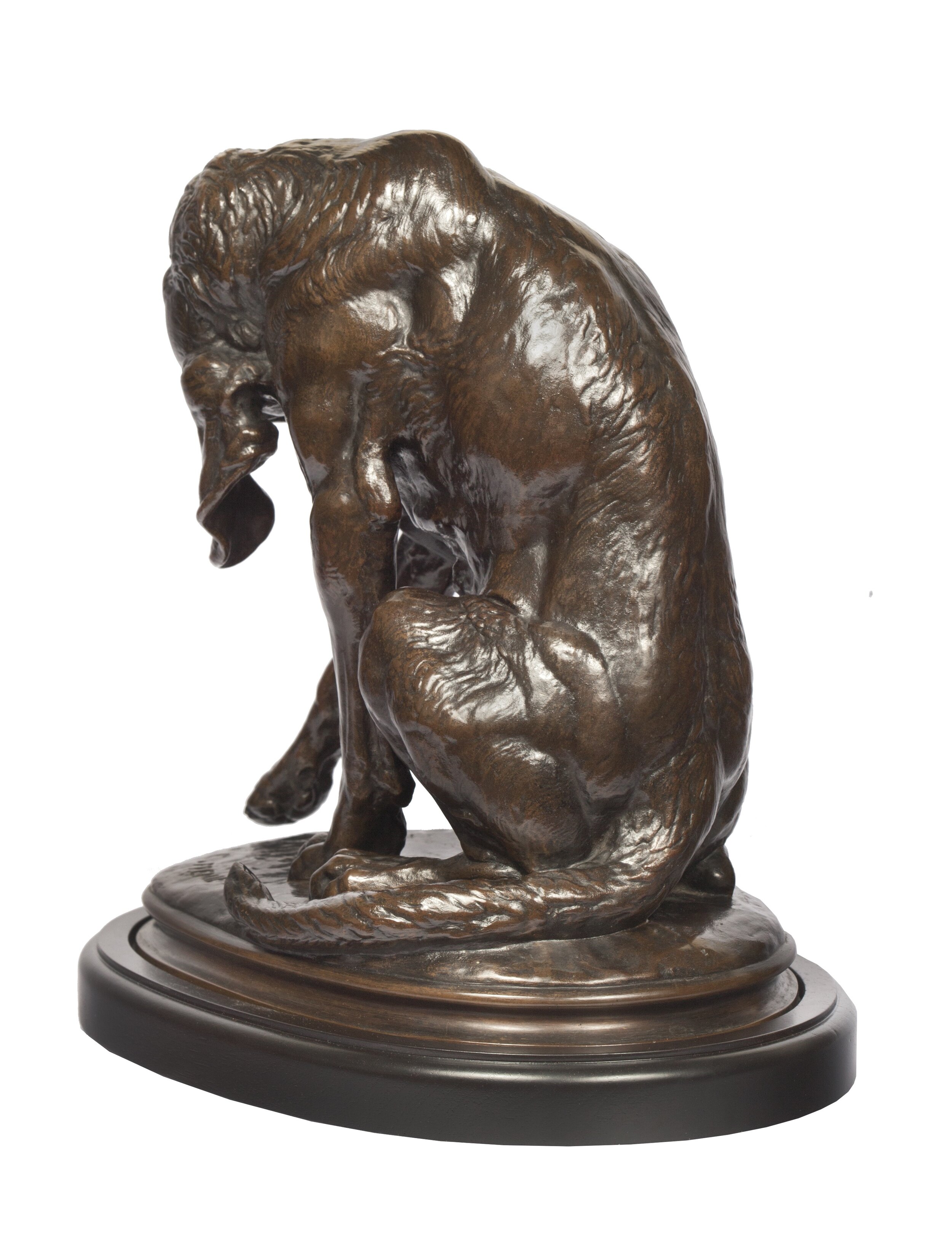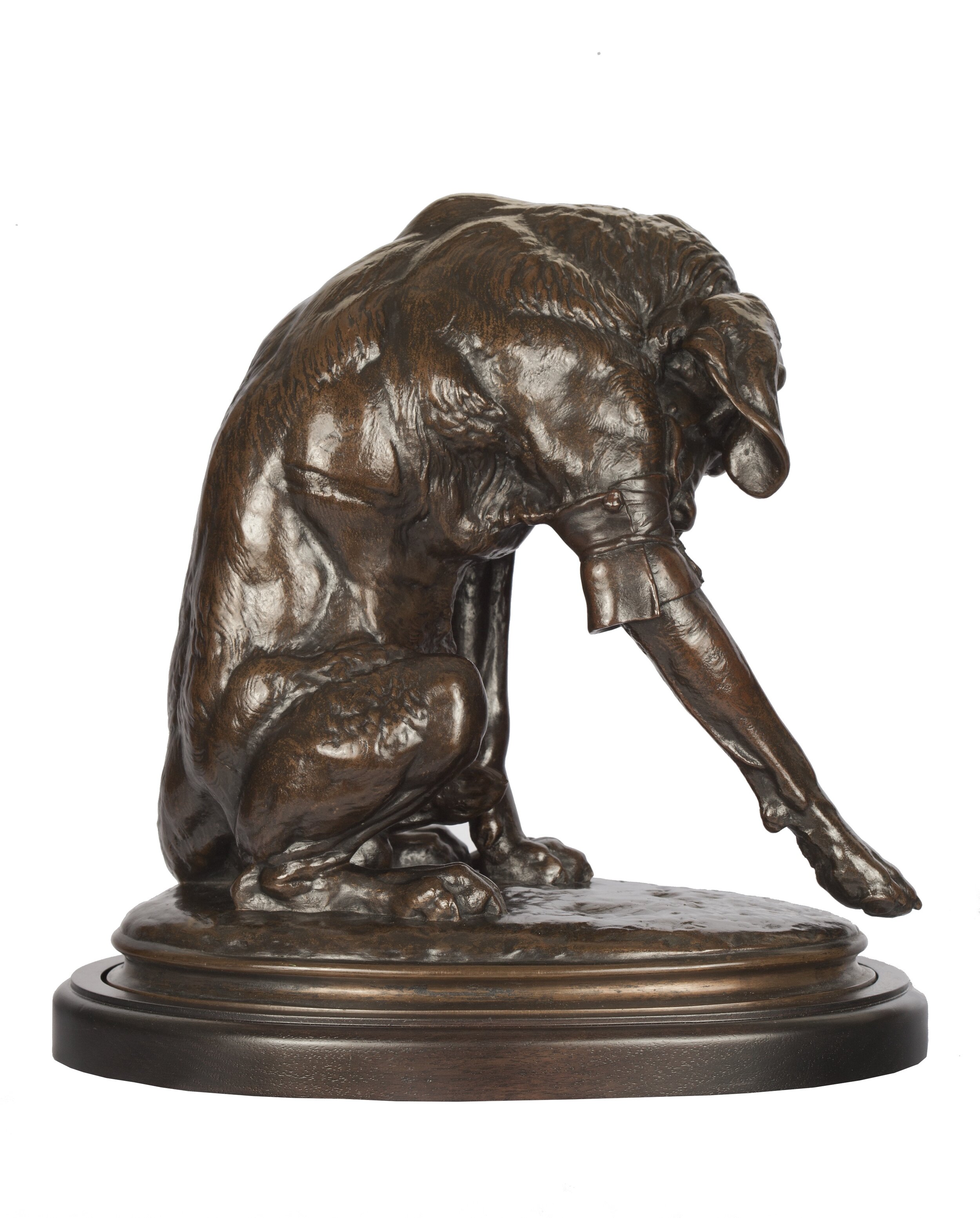


EMMANUEL FRÉMIET (Paris 1824 – Paris 1910)
Chien Courant Blessé (Wounded Hound)
signed E. Fremiet, and cold stamped 2 on the base (Charles More Cast)
bronze with dark brown patina with warmer light brown highlights
height 10 inches (25.4 cm), length 11 inches (27.9 cm)
PROVENANCE
The Sladmore Gallery, London, where purchased by
Private Collection, New York
Emmanuel Frémiet was one of the most highly regarded animalier sculptors of his time. His training began under the tutelage of his aunt Sophie Frémiet, who taught him sketching and modeling. In 1840, at the age of 16, Frémiet was apprenticed to the artist Jacques Christophe Werner, the official painter of the natural history museum at the Jardin des Plantes. Within the atelier, Frémiet worked as a lithographer, preparing drawings of birds and animals for reproduction. After about two years, he left to join the studio of famed sculptor François Rode, who also was the husband of Sophie Frémiet. In 1843, Frémiet submitted his first work to the Salon, a study of a Gazelle in plaster. For the next twelve years, he showed mainly animals, executed in wax, terracotta, plaster and bronze.[1] What led Frémiet in this direction was the immense success of Chien Courant Blessé or the Wounded Hound, when exhibited in the Salon of 1856.
Purchased immediately by the Luxembourg Museum (now the Musée d’Orsay, Paris),[2] Wounded Hound also succeeded in capturing the hearts of visitors to the Salon. Reviews such as, “a wounded dog ... made him famous as a rival of (Antoine Louis) Barye”[3]; “wounded dog... excites general sympathy”;[4] “a striking example of his work”[5]; and “Wounded Hound... made a great sensation,”[6] were typical. When a plaster cast of the work, executed for the Chicago Art Institute, was exhibited at The World’s Columbian Exposition of 1893, the response from the painter and art critic William A. Coffin was “Wounded Dog... admirable from every point of view”[7]. Even Frémiet’s 1910 obituary in The New York Times noted, “his masterpiece ‘The Wounded Hound’”.[8] Recently, its inclusion in the 2007 book, 1,000 Sculptures of Genius, a survey of works from antiquity to modern times, speaks volumes.[9] Casts of Wounded Hound can also be found in the Victoria and Albert Museum, London as well as the Kunsthalle, Hamburg.
From 1860 onwards, many public commissions were awarded to Frémiet. He was also involved in the redecoration of the Louvre. Further a penchant for equestrian statues came to the forefront. Representative examples include: The Torchbearer, Town Hall, Paris; Velasquez, Louvre; and Colonel Howard, Baltimore. Much of his later works exhibit a strong classical bend; i.e. Man and Bear in Combat, 1885; Love Attacking the Peacock of Juno, 1900; and Minerva in a Chariot Drawn by Three Horses, 1900.[10]
Although he had a lifetime filled with success and honors, Frémiet chose to live simply, with much time devoted to family.[11] Throughout his career, his love of animals remained his primary motivating force, the strength of which will forever resonate within this Wounded Dog.
[1] Biographical information taken from James Mackay, The Animaliers, E.F. Dutton & Co., Inc., New York, 1973, pp. 39-40; Christopher Payne, “Emmanuel Frémiet” in Animals in Bronze, Antique Collectors’ Club, Wappinger Falls, New York, 1986, p. 404; and Pierre Kjellberg, “Emmanuel Frémiet” in Bronzes of the 19th Century, Schiffer Publishing Ltd., Atgelen, PA., 1994, p. 330.
[2] “The Orsay Zoo” on musee-orsay.fr website.
[3] George Ripley, Charles A. Dana, eds., “Emmanuel Frémiet in The American Cyclopedia: A Popular Dictionary of General Knowledge, D. Appleton and Company, New York, 1874, p. 477.
[4] Daniel Cady Eaton, “Emmanuel Frémiet” in A Handbook of Modern French Sculpture, Dodd, Mead and Company, New York, 1913, p. 200.
[5] “Emmanuel Frémiet” in The Encyclopaedia Brtannica, volume XI, The Encyclopaedia Britannica Company, New York, 1910, p. 97.
[6] “Emmanuel Frémiet” in The New International Encyclopaedia, volume IX, Dodd, Mead and Company, New York, 1917, p. 235.
[7] “Emmanuel Frémiet” in World’s Columbian Exposition, Department of Fine Arts, W.B. Conkey Company, Chicago, 1893, p. 209; and William A. Coffin, “The Columbian Exposition – Fine Arts: French and American Sculpture” in The Nation, volume 57, no. 1466, August 3, 1893, p. 80.
[8] “Emmanuel Fremiet Dead, A Master in Animal Sculpture and Officer of Legion of Honor” in The New York Times, September 11, 1910.
[9] See, Joseph Manca, Patrick Bade, Sarah Costello, 1,000 Sculptures of Genius, Sirrocco, London, 2007, no. 673, unpaginated.
[10] James Mackay, op. cit., pp. 42-43.
[11] Pierre Kjellberg, op.cit., p. 330.